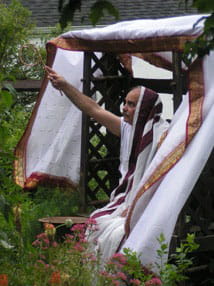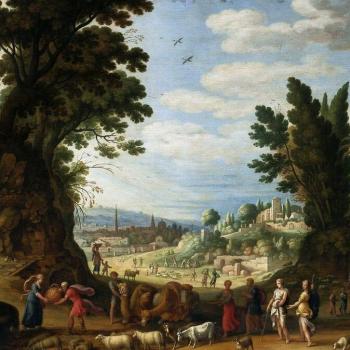As we look ahead, our effort shall be to bring individuals and families of cultores from different organizations together into the local temple communities. Then these local communities will link up with one another into statewide, regional, or national organizations. Thus, what had in recent years began as internet communities organizing from the top down are now changing over to grassroots organizing from the local level up. This shall become more important as the Religio Romana seeks wider recognition.
 Scholarly interest in the religious traditions of ancient Rome has really come into its own only in the past couple of decades. The early history of a modern Religio Romana had the reconstruction of rituals as a primary interest, and thus practice was a main focus. Ritual practice has led to more experience in the tradition itself, and what we find today is that more and more cultores Deorum are finding spiritual experience through ritual. Formal Roman ritual involves pomp and repetition. The formalism and repetition leads into a state of ritual consciousness that can at times then lead into the other side of the Religio Romana which derives from its origin in an ecstatic tradition. This has led to an interest away from "reconstructionist" practice to the simpler and more pious practice of the Numa tradition. What this means for the future of the Religio Romana is the awakening of a new spirituality among cultores Deorum.
Scholarly interest in the religious traditions of ancient Rome has really come into its own only in the past couple of decades. The early history of a modern Religio Romana had the reconstruction of rituals as a primary interest, and thus practice was a main focus. Ritual practice has led to more experience in the tradition itself, and what we find today is that more and more cultores Deorum are finding spiritual experience through ritual. Formal Roman ritual involves pomp and repetition. The formalism and repetition leads into a state of ritual consciousness that can at times then lead into the other side of the Religio Romana which derives from its origin in an ecstatic tradition. This has led to an interest away from "reconstructionist" practice to the simpler and more pious practice of the Numa tradition. What this means for the future of the Religio Romana is the awakening of a new spirituality among cultores Deorum.
While Rome was said to have been founded by Romulus, its first King, the Religio Romana has been traditionally attributed to Numa Pompilius, the second King of Roma antiqua. The Numa tradition refers to that original form of the Religio Romana. The presence of the Gods and Goddesses are found in Nature. A verdant grove, a spring, a tree of unusual proportion might result from the presence of a God or Goddess. Thus the early templa of the Religio Romana were such places, no more than a sacred grove with a fresh water spring and an altar.
Still today we connect with the Gods more often in Nature than in anywhere else. The Gods are represented by the altar flame. This is best seen with the worship of Vesta, Goddess of the Hearth and Home, Who may only be represented by a flame. While statues and other images might be used for decorative purposes of the home, under the Numa tradition no images of the Gods are used during ritual. Ritual is to be complex so that it is not performed in haste or a perfunctory manner. Numa forbade the use of blood sacrifices, and was thus the first to introduce offerings of grain, salt, oil, milk and the first fruits of our gardens and fields.
"Rightly," said Persius, "what is proper and just to offer the Gods are holiness of mind and purity of heart in the deepest recesses of our being." Pliny the Younger told us that "The Gods rejoice more in the innocence of worshippers than in elaborate prayers; the man who enters their temples with a pure heart is more agreeable to them than one who recites a carefully prepared litany." Also Cicero said that we should "approach the Gods and Goddesses while pure and chaste, bringing piety, and leaving riches behind." All of these Romans expressed a return to the Numa tradition that modern cultores Deorum are adopting in their practices as well. While our rituals have been evolving to these more complex, more austere and pious rituals, they bring us back to Numa's own example of speaking directly with the Gods.
This leads to a different way that cultores Deorum think about Roman ritual, and thus how they practice our tradition. Historians necessarily dwell on the state religion of Rome as it developed during the Late Republic and under Caesar Augustus. The state religion was filled with display, excesses, and the contractual form of petitions addressed to the Gods. This is what is known as the do ut das formula. ("I give, so that You may give.") In contrast, the ritual of the Numa tradition -- where one attends with purity and piety, where one sits between each stage of ritual to reflect, and where the emphasis is on communing with the Gods rather than petitioning to Them -- naturally leads to a more personal religion. This is due in part to our emphasis on daily worship of the Lares, who are the spirits of our departed family members, and of the household Gods known as the Penates.
So on one level the Religio Romana embraces a kind of spiritualism; ancestor worship is what distinguishes the Religio Romana from other polytheist traditions of the Mediterranean region. Festival days are devoted to celestial deities -- Jupiter, Juno, Minerva, Ceres, and Magna Mater being some of the main deities worshipped. But the approach toward Them is in a personal way, in a familial manner, not as abstract entities or impersonal beings, but as forces in Nature that treat us as loving parents. Some of the mysteries, some of our rituals, heighten this sense of the presence of the Gods being personally alongside us, not looking over our communities but within our communities as active members.




